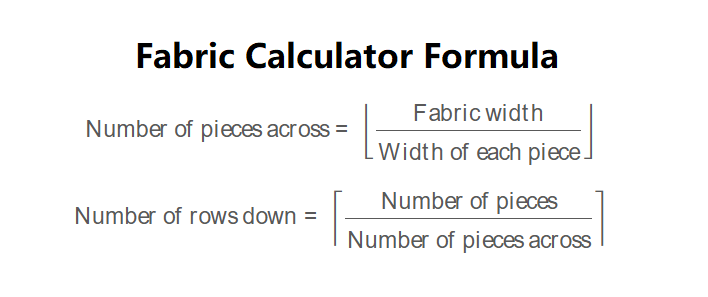1. What is a Fabric Calculator?
Definition: This calculator estimates the total amount of fabric needed for a project involving multiple pieces of the same size, such as tablecloths, napkins, or quilts.
Purpose: It helps users determine the length of material required, the number of pieces that can fit across the fabric width, and the number of rows needed, ensuring efficient fabric usage.
2. How Does the Calculator Work?
The calculator uses the following formulas:
\[
\text{Number of pieces across} = \left\lfloor \frac{\text{Fabric width}}{\text{Width of each piece}} \right\rfloor
\]
\[
\text{Number of rows down} = \left\lceil \frac{\text{Number of pieces}}{\text{Number of pieces across}} \right\rceil
\]
\[
\text{Length of material needed} = \text{Length of each piece} \times \text{Number of rows down}
\]
Unit Conversions:
- mm: 1 mm = 0.0393701 in
- cm: 1 cm = 0.393701 in
- dm: 1 dm = 3.93701 in
- m: 1 m = 39.3701 in
- in: 1 in = 1 in
- ft: 1 ft = 12 in
- yd: 1 yd = 36 in
Steps:
- Enter the fabric width, width of each piece, length of each piece, and the number of pieces, selecting the unit for each measurement.
- Convert all measurements to inches for calculation.
- Calculate the number of pieces that can fit across the fabric width (rounded down).
- Calculate the number of rows needed (rounded up).
- Calculate the total length of material needed.
- Convert the result to the selected output unit and display the results.
3. Importance of Fabric Calculation
Calculating fabric requirements is crucial for:
- Material Efficiency: Ensures you purchase the correct amount of fabric, reducing waste.
- Cost Savings: Prevents overbuying or underbuying fabric, saving money.
- Project Planning: Helps plan the layout of pieces on the fabric, ensuring the project can be completed as intended.
4. Using the Calculator
Examples:
- Example 1: Fabric Width = 54 in, Width = 6 in, Length = 6 in, Number of Pieces = 27:
- Number of pieces across: \( \left\lfloor \frac{54}{6} \right\rfloor = 9 \)
- Number of rows down: \( \left\lceil \frac{27}{9} \right\rceil = 3 \)
- Length of material needed: \( 6 \times 3 = 18 \, \text{in} \)
- In yards: \( 18 \div 36 = 0.5 \, \text{yd} \)
- Example 2: Fabric Width = 120 cm, Width = 20 cm, Length = 30 cm, Number of Pieces = 20:
- Convert: Fabric Width = \( 120 \times 0.393701 = 47.24 \, \text{in} \), Width = \( 20 \times 0.393701 = 7.87 \, \text{in} \), Length = \( 30 \times 0.393701 = 11.81 \, \text{in} \)
- Number of pieces across: \( \left\lfloor \frac{47.24}{7.87} \right\rfloor = 6 \)
- Number of rows down: \( \left\lceil \frac{20}{6} \right\rceil = 4 \)
- Length of material needed: \( 11.81 \times 4 = 47.24 \, \text{in} \)
- In cm: \( 47.24 \div 0.393701 = 120 \, \text{cm} \)
5. Frequently Asked Questions (FAQ)
Q: What if my fabric width is not enough for even one piece?
A: The calculator will display an error. You may need to choose a wider fabric or adjust the width of your pieces.
Q: Should I account for seam allowances?
A: Yes, it's recommended to add seam allowances to the width and length of each piece before using the calculator to ensure you have enough fabric.
Q: What if I need pieces of different sizes?
A: This calculator assumes all pieces are the same size. For different sizes, calculate each size separately and sum the total material needed.
 Home
Home
 Back
Back
